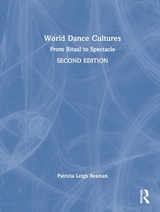
World Dance Cultures
Routledge (Verlag)
978-1-138-90772-0 (ISBN)
- Titel erscheint in neuer Auflage
- Artikel merken
From healing, fertility and religious rituals, through theatrical entertainment, to death ceremonies and ancestor worship, World Dance Cultures introduces an extraordinary variety of dance forms practiced around the world.
This highly illustrated textbook draws on wide-ranging historical documentation and first-hand accounts, taking in India, Bali, Java, Cambodia, China, Japan, Hawai’i, New Zealand, Papua New Guinea, Africa, Turkey, Spain, Native America, South America, and the Caribbean.
Each chapter covers a certain region’s distinctive dances, pinpoints key issues and trends from the form’s development to its modern iteration, and offers a wealth of study features including:
Case Studies – zooming in on key details of a dance form’s cultural, historical, and religious contexts
‘Explorations’ – first-hand descriptions of dances, from scholars, anthropologists and practitioners
‘Think About’ – provocations to encourage critical analysis of dance forms and the ways in which they’re understood
Discussion Questions – starting points for group work, classroom seminars or individual study
Further Study Tips – listing essential books, essays and video material.
Offering a comprehensive overview of each dance form covered with over 100 full color photos, World Dance Cultures is an essential introductory resource for students and instructors alike.
Patricia Leigh Beaman is on the dance faculty at Wesleyan University and teaches dance history at New York University. As a Baroque and contemporary dancer, she has worked nationally and internationally, and is currently exploring the juxtaposition between historical Baroque and Postmodern dances of the 1960s.
CHAPTER 1 - India: Devotion, dance, and mythology
1.1 Overview
1.2 Bharatanatyam: concertizing a sacred form from South India
1.2 Exploration: excerpt from Unfinished Gestures: Devadasis, Memory, and Modernity in South India, by Davesh Soneji
1.3 Kathak: entertainment for Hindu Maharajas and Muslim Moghuls
1.4 Kathakali: narrative dance theater from Kerala
1.4 Exploration: excerpt from "Who Wears the Skirts in Kathakali?" by Diane Daugherty and Marlene Pitkow
CHAPTER 2 - Bali and Java: from temple, to village, to court
2.1 Overview
2.2 The baris dancers: bodyguards of Balinese gods
2.3 The sanghyang dedari: child mediums to the spirit realm
2.4 The legong: when sacred dances become secular
2.5 The calonarang: keeping a community in balance
2.5 Exploration: excerpt from "Clowns, Kings, and Bombs in Bali," by Ron Jenkins
2.6 Javanese bedhaya: celestial palace dance
2.6 Exploration: excerpt from The Dance that Makes You Vanish, by Rachmi Diyah Larasati
CHAPTER 3 - Cambodia and China: Dance as a political tool
3.1 Overview
3.2 Cambodia’s royal dancers: survivors of the Khmer Rouge
3.2 Exploration: excerpt from "Mediating Cambodian History, the Sacred, and the Earth," by Toni Shapiro-Phim
3.3 Jingju: Chinese Beijing Opera--stylized beauty, staged
3.4 Mao’s Cultural Revolution and The Red Detachment of Women
3.4 Exploration: excerpt from The Story of Dai Ailain, by Richard Glasstone
CHAPTER 4 - Japanese noh, kabuki, and butoh: Entertaining samurai, merchants, and rebels
4.1 Overview
4.2 Noh theater: entertaining samurai
4.2 Exploration: excerpt from "Import/Export: Artistic Osmosis Between Japan, Europe, and the United States" by Patricia Leigh Beaman
4.3 From pleasure women’s kabuki to Grand Kabuki Theater
4.4 Butoh: Japan’s dance of darkness
4.4 Exploration: excerpt from "Selections from the Prose of Kazuo Ohno" by Noriko Maehata
CHAPTER 5 - Hawai'i, Aotearoa/New Zealand, and Papua New Guinea: Guardians of culture
5.1 Overview
5.2 Hula kahiko: from Hawaiian royal courts to the global stage
5.3 The Māori haka: a dance of defiance, a dance of welcome
5.3 Exploration: excerpt from "Ko Mitimiti Ahau, I am (of) the Place, Mitimiti" by Jack Gray
5.4 The gisalo: pathos and pain of the Bosavi-Kaluli of Papua New Guinea
5.4 Exploration: excerpt from The Sorrow of the Lonely and the Burning of the Dancers by Edward Schieffelin
CHAPTER 6 - Africa: Fertility festivals, death ceremonies, and ancestor worship
6.1 Overview
6.2 The Geerewol Festival of the Wodaabe: judging male charm and beauty
6.2 Exploration: excerpt from Nomads Who Cultivate Beauty by Mette Bovin
6.3 The Dogon dama ceremony: a collective funeral ritual
6.4 The Mossi: yaaba sooré--the path of the ancestors
6.4 Exploration: excerpt from Land of the Flying Masks by Christopher Roy
6.5 The Egungun of Yorubaland: the ancestors descend
CHAPTER 7 - North Africa, Turkey, and Spain: Healing, worship, and expression
7.1 Overview
7.2 The zār ritual: ridding women of troublesome jinn
7.2 Exploration: excerpt from Wombs and Alien Spirits: Women, Men, and the Zār Cult in Northern Sudan by Janice Boddy
7.3 The sema: mystical dance of the Sufi Mevlevi dervish
7.3 Exploration: excerpt from The City of the Sultan by Julia Pardoe
7.4 Flamenco: a manifestation of cultures and passions
CHAPTER 8 - Native America, the Caribbean, and South America: Resistance, spirituality, and spectacle
8.1 Overview
8.2 Political resistance: the Lakota Ghost Dance and Wounded Knee, 1890 and 1973
8.2 Exploration: excerpt from Killing Custer: The Battle of the Little Bighorn and the Fate of the Plains Indians, by James Welch and Paul Stekler
8.3 Haitian vodou: an Afro-Caribbean spiritual pathway
8.3 Exploration: excerpt from "Afro-Caribbean Spirituality: A Haitian Case Study" by Karen McCarthy Brown
8.4 Tango: from Argentinian dens of iniquity, to Parisian dance halls, and back
Glossary
Index
| Erscheinungsdatum | 16.02.2016 |
|---|---|
| Zusatzinfo | 172 Halftones, black and white |
| Verlagsort | London |
| Sprache | englisch |
| Maße | 189 x 246 mm |
| Gewicht | 952 g |
| Themenwelt | Kunst / Musik / Theater ► Theater / Ballett |
| Sachbuch/Ratgeber ► Sport ► Tanzen / Tanzsport | |
| Sozialwissenschaften ► Soziologie | |
| ISBN-10 | 1-138-90772-3 / 1138907723 |
| ISBN-13 | 978-1-138-90772-0 / 9781138907720 |
| Zustand | Neuware |
| Informationen gemäß Produktsicherheitsverordnung (GPSR) | |
| Haben Sie eine Frage zum Produkt? |
aus dem Bereich



